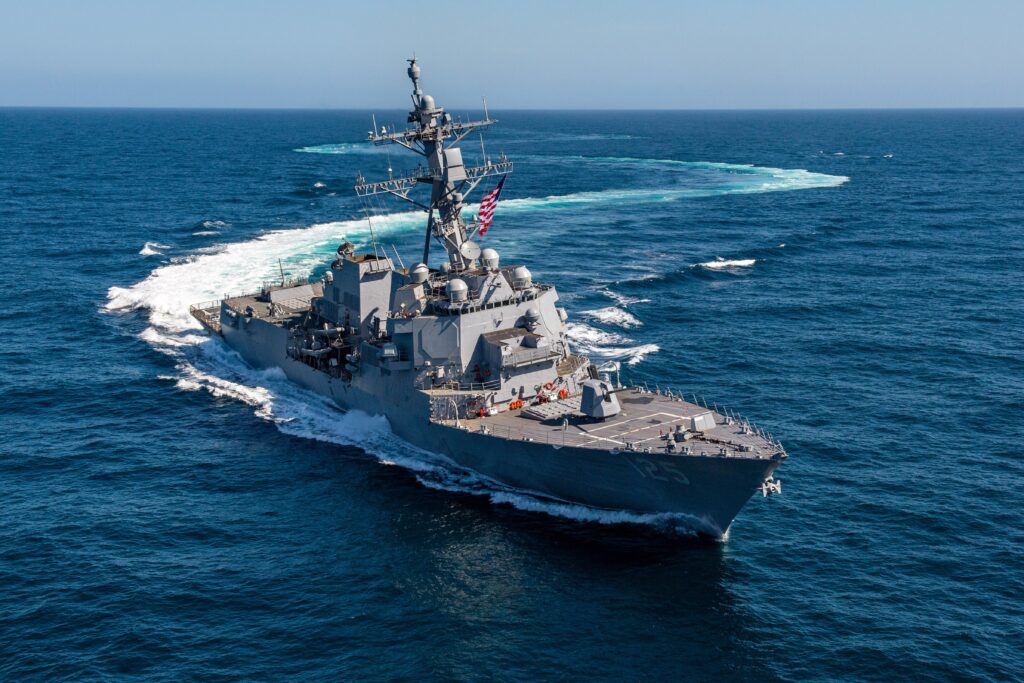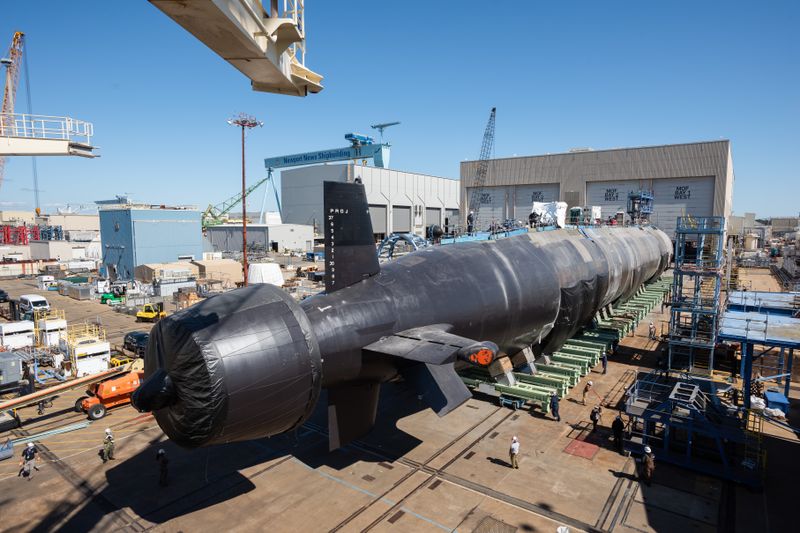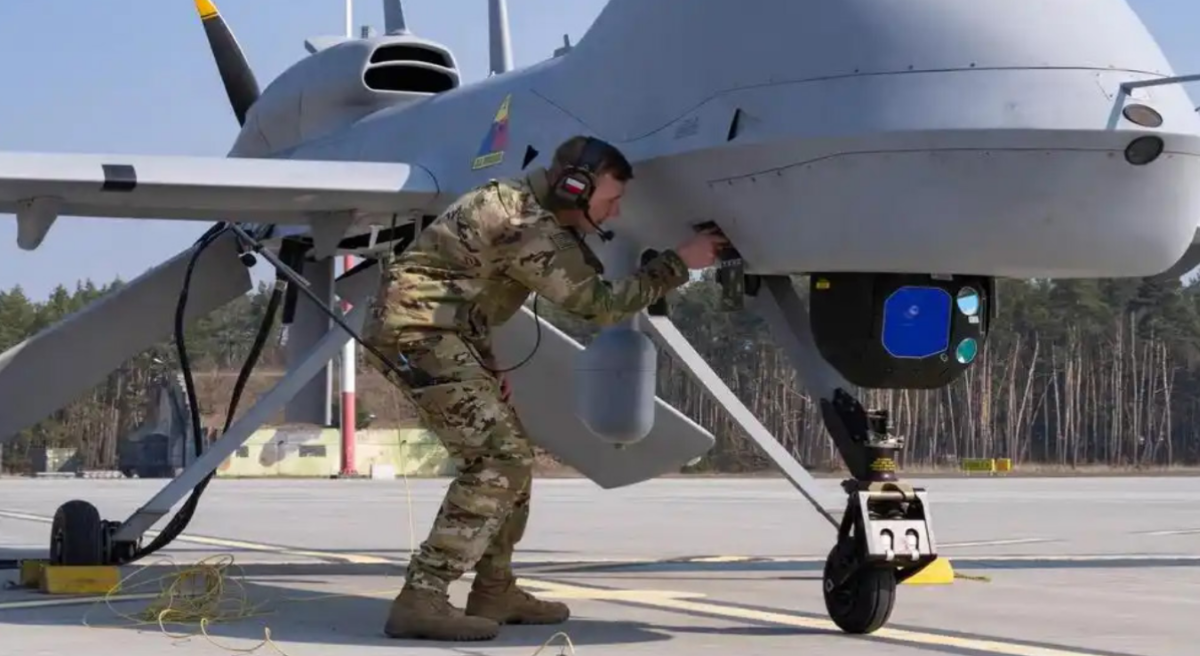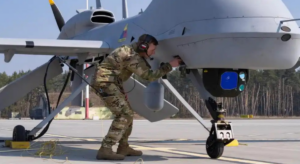NATO Nuclear Mission. While Pantex said in May that it built the first production B61-13 nuclear gravity bomb almost a year early on the heels of the last B61-12 coming off the line, the Royal Air Force (RAF) is to buy 12 new Lockheed Martin F-35A fighters capable of carrying conventional munitions and the B61-12–the latter allowing the RAF to join NATO’s nuclear mission. The office of United Kingdom (U.K.) Prime Minister Keir Starmer said that the new F-35A buy supports 20,000 jobs “with 15 percent of the global supply chain for the jets based in Britain” and that the F-35As will fly from RAF Markham. They are part of a U.K. planned buy of 138 F-35s. “The purchase represents the biggest strengthening of the U.K.’s nuclear posture in a generation,” Starmer’s office said. “It also reintroduces a nuclear role for the Royal Air Force for the first time since the U.K. retired its sovereign air-launched nuclear weapons following the end of the Cold War.”
Space GMTI Production.
The U.S. Space Force’s fiscal 2026 budget request includes nearly $1.1 billion in research and development for space-based ground moving target indication (GMTI) to replace the now retired Joint STARS aircraft by Northrop Grumman. The Space Force request says that the classified development of space-based GMTI by the service and the National Reconnaissance Office will replace “a portion” of the former Joint STARS fleet–a construct based on the Space Force’s Space Warfighting Analysis Center’s (SWAC) analysis of alternatives in September 2022. The plans for space-based GMTI have called for a System Requirements Review for the first block of planned systems by the end of September. The increase between fiscal 2025 and fiscal 2026 in the Space Force’s desired funding for space-based GMTI is “due to ramp-up of production consistent with the program baseline,” Space Force said. The fielding of space-based GMTI is to end in the fourth quarter of fiscal 2030.
Rocket Lab CDR. Rocket Lab USA said that it has finished Critical Design Review (CDR) of its 18 satellites for the U.S. Space Force Space Development Agency’s (SDA) Tranche 2 Transport Layer-Beta (T2TL-Beta) program. “The milestone follows Rocket Lab’s successful Preliminary Design Review in late 2024, confirms that spacecraft design, manufacturing approach, and systems architecture meet all mission requirements and enables the program to move into full-scale production,” the company said. “Rocket Lab’s spacecraft for the T2TL-Beta program is based on its high-performance Lightning platform, tailored for the power and data-handling demands of national security LEO [low Earth orbit] constellations. As a vertically integrated provider, Rocket Lab designs and manufactures its spacecraft buses and key subsystems in-house, including solar panels, composite structures, star trackers, reaction wheels, radios, avionics, flight and ground software, launch dispensers, and more allowing the company to maintain tight control over quality, cost, and schedule.”
DDG-129. The Navy and HII christened the future USS Jeremiah Denton (DDG-129) Flight III Arleigh Burke-class destroyer on June 28. The ship is named after former Sen. Jeremiah Denton (R-Ala.), who served in the Navy during the Vietnam War and was awarded a Navy Cross for heroism as a prisoner of war. Beyond this ship, HII’s Ingalls Shipbuilding in Pascagoula, Miss., has four other Flight III DDGs under construction: the future USS Ted Stevens (DDG-128), George M. Neal (DDG-131), Sam Nunn (DDG-133) and Thad Cochran (DDG-135). The Flight III destroyers feature upgrades and modifications to accommodate the ANSPY-6(V)1 Air and Missile Defense Radar.
SSN-800. HII announced on July 2 it recently launched the future USS Arkansas (SSN-800) Virginia-class submarine into the James River at its Newport News Shipbuilding (NNS), Va., facility. The shipbuilders did this to transfer the boat from construction to a floating dry dock facility to move on to final outfitting, testing and crew certification. SSN-800 will be the 27th Virginia-class submarine and 13th delivered by NNS.
MCM Sea Breeze. Naval forces from 13 countries started the nearly two-week-long Exercise Sea Breeze 25-2 on June 30, a mine countermeasure (MCM)-focused exercise, in Portland, England, U.K. Participants plan to perform mine hunting operations using MCM Vessels (MCMVs), explosive ordnance disposal teams, dive and salvage operations, unmanned underwater vehicles 9UUVs) and unmanned surface vessels (USVs). The exercise is meant to provide the NATO allies and partner countries with the ability to enhance interoperability and warfighting in the Black Sea region. The exercise will culminate in a demonstration that combines various capabilities. This is the second part of Sea Breeze 25, with section 25-1 hosted by the Romanian Armed Forces at Smardan Range, Romania, June 1-20, 2025. Black Sea and NATO partners have been training under the annual Exercise Sea Breeze since 1997.
RIMPAC 2026 Planning. Representatives from several countries met in San Diego for the Initial Planning Conference for the 30th iteration of biennial Exercise Rim of the Pacific (RIMPAC), scheduled for summer 2026. Commander of U.S. Third Fleet Vice Adm. John Wade said the partners were brought in “to align on shared objectives, discuss potential training scenarios, and lay the groundwork for an exercise that will enhance our collective interoperability and readiness to respond to the complex challenges of the maritime domain.”
UNITAS 2025 Planning. U.S. Naval Forces Southern Command/U.S. 4th Fleet hosted the final planning conference (FPC) for the 66th iteration of UNITAS 2025 from June 23-27, following the April main-planning conference. UNITAS 2025 is scheduled to run from Sept. 15 to Oct. 6 off the East Coast of the U.S., with shore-based events at Naval Station Mayport, Marine Corps Base Camp Lejeune, N.C., Naval Station Norfolk, Va., and Naval Air Station Oceana, Dam Neck Annex. UNITAS is set to include a variety of maritime and littoral operations, including a live-fire sinking exercise (SINKEX) and amphibious landings. The Navy said it will also show off maritime technology like unmanned and hybrid fleet systems, culminating in unspecified high-end warfighting events. The FPC included over 250 representatives from over 210 countries, including Argentina, Belize, Brazil, Canada, Chile, Colombia, Dominican Republic, Ecuador, El Salvador, France, Germany, Greece, Guatemala, Honduras, Jamaica, Japan, Mexico, Panama, Paraguay, Peru, Singapore, Spain, and the U.S.
AV Raise. AeroVironment last week announced offerings of common stock and senior notes expected to raise about $1.5 billion in funding, with most of the new funding going toward existing debt repayments and the remainder, just over $500 million for general corporate purposes such as increasing manufacturing capacity. AV is bullish on its future growth and is already expanding production capacity to meet anticipated demand for its drones and other defense products.
IPMDA Expansion. The Quad last week announced the geographic expansion of the Indo-Pacific Partnership for Maritime Domain Awareness (IPMDA) across the Indian Ocean region. Begun during the Biden administration, the IPMDA is focused on maintaining a near-real-time maritime domain awareness picture in the Indo-Pacific region. “We continue to implement the Indo-Pacific Partnership for Maritime Domain Awareness, including the increased provision of space-based collection and sharing of radio frequency data, analytical training, and capacity building,” the Quad Foreign Ministers said in a statement July 1. Development of an IPMDA common operation picture is still being assessed, they said. The Quad consists of the U.S., Australia, India, and Japan.
…Critical Minerals. The latest meeting of the Quad Foreign Ministers also resulted in the launch of a Critical Minerals Initiative focused on “security and diversifying critical mineral supply chains.” The initiative includes working with the private sector to help increase investments in critical materials.
TransDigm Deal. TransDigm deal last week closed its acquisition of Servotronics, a designer and manufacturer of highly engineered servo valves to the commercial aerospace and defense market. Servotronics has about 275 employees generated about $45 million in sales in 2024.
Coast Guard sUAS. The Coast Guard last week awarded Parrot ANAFI a $68,000 contract to purchase three of the company’s UKR drone kits, spare batteries, and propellers for an operational test and evaluation of the Parrot ANAFI UKR small quadcopter drones to support service missions. The service currently uses the Parrot ANAFI USA drones, which Parrot has discontinued manufacturing. The short-range small unmanned aircraft systems will “support the full scope of Coast Guard missions and this initial procurement will also support test and evaluation that informs development of training materials including launch and recovery procedures for underway operations,” a service spokesperson told Defense Daily.
Big C-UAS Award. Australia’s DroneShield last month announced its largest ever single order, nearly $41 million, to provide handheld detection and counter-drone systems, and related equipment to a European military customer. The company expects to complete deliveries by the end of September. DroneShield had less than $38 million in sales in 2024. Separately, the company received $6 million in contracts from a defense customer in Latin America for handheld and on-the-move counter-unmanned aircraft systems.
Space Warning. The threat environment to space-related systems from malicious cyber activity and electronic warfare is at a “heightened” level and are exacerbated by conflicts in the Middle East, leading government agencies and the private sector to “warn that low-level attacks may soon rise to sophisticated attacks,” the Space Information Sharing and Analysis Center (ISAC) said last week. Contributing factors leading to the higher threat level include an increase in targeting against organizations in the space and related sectors, existing and new hacktivist groups targeting entities in the national security, defense, and space sphere, interference with Global Navigation Satellite Systems in parallel with geopolitical events, threat groups using as-a-service tools to navigate past cybersecurity protections, and variable risks stemming from a dynamic space environment, the ISAC said. The Space ISAC is an all-threat information sharing center.
Bacon Retiring. Rep. Don Bacon (R-Neb.), chair of the House Armed Services Committee’s Cyber, Information Technologies and Innovation Subcommittee, confirmed on June 30 he will not seek reelection in 2026. Bacon, 61, was first elected to represent Nebraska’s 2nd district in 2016, which followed 29 years of service in the Air Force where he retired in 2014 as a brigadier general. “After three decades in the Air Force and now going on one decade in Congress, I look forward to coming home in the evenings and being with my wife and seeing more of our adult children and eight grandchildren, who all live near my home,” Bacon said in a statement. In his announcement, Bacon noted his support for Offutt Air Force in his district and his work to push for a new DoD electronic warfare strategy and efforts to bolster the Air Force’s fleet of EA-37B Compass Call aircraft. Bacon, a moderate, has recently voiced opposition to several Trump administration efforts, including the White House’s tariffs policy.
Machine Guns. The Army has awarded FN America a $4.9 million contract to supply more M240L lightweight medium machine guns, the company said on July 1. “The M240L continues the collaborative effort between FN, the U.S. Army and the individual soldier to provide the most effective weapon systems for the warfighter,” Mark Cherpes, president and CEO of FN America, said in a statement. “The development saw the introduction of new materials along with new manufacturing techniques that have paved the way for the future generation of military equipment. We are extremely proud of this product and look forward to working with the U.S. Army to deliver against this contract.”
UKR Aid Pause. Chief Pentagon Spokesman Sean Parnell confirmed on July 2 that DoD has paused the shipment of some weapons and munitions to Ukraine, but said the department won’t be providing details on the specific capabilities and quantities included in the decision or associated timelines. “The Department of Defense continues to provide the president with robust options regarding military aid to Ukraine, consistent with his goal of bringing this tragic war to an end. And at the same time, the Department is rigorously examining and adapting its approach toward achieving this objective while also preserving U.S. military readiness and defense priorities that supports the president’s America first agenda,” Parnell said in a briefing. Parnell described the security assistance pause as a “capability review.” “[It’s] being conducted to ensure U.S. military aid aligns with our defense priorities,” Parnell added.
…Push Back Sen. Jeanne Shaheen (D-N.H.), the top Democrat on the Foreign Relations Committee, pushed back on the Trump administration’s pause and addressed reports the decision was made to halt munitions transfers to Ukraine due to concerns related to the level of U.S.’ weapons stockpiles. “The Pentagon is significantly weakening Ukraine’s defense against aerial attacks even as Russia pounds Ukrainian cities night after night, with numerous civilians dead and wounded. President Trump pledged just last week to look for additional air defense systems for Ukraine, but [Defense] Secretary [Pete] Hegseth and Under Secretary [of Defense for Policy Elbridge] Colby seem to be ignoring him. If there is a real concern over stockpiles, the administration should consult with the relevant committee in advance,” Shaheen said. Parnell, in his briefing, addressed the reports on stockpile concerns and said “our military has everything that it needs to conduct any mission, anywhere, anytime, all around the world.”











